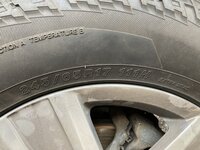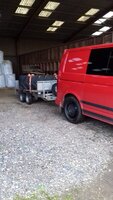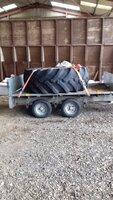This is my view:-
If off-road is your major issue in choosing a tyre, then the smallest rim with the largest tyre (diameter) is the way to go, because you can run that set up with the lowest pressure off-road (low speed`) subject to having some good ply sidewalls; without fear of the tyre coming off the rim, or damaging the rim (you can even consider rim locks). Giving the lowest ground pressure (sand and other soft surfaces), and most conformable tyre for hard angular surfaces. Low tyre pressure = low ground pressure mostly within the limits of the tyre.
The thinner tyre argument comes from driving on cohesive/clay soils or ice. In these situations the substrate is approaching frictionless, so you need to punch through the surface and try to shear the ice or clay across itself.
Regarding tyre loads, there is absolutely no need to select tyres with extra load ratings (VW don't, they sell T32 with 103 tyres - which is the minimum load rating for the heaviest loaded axel. The tyre load standards relate primarily to the tyre over-heating in maximum duty conditions (i.e. running at the tyres maximum speed duty & maximum loading in maximum ambient temperature conditions with maximum gross train weight & axel weight including a 2.5T trailer on the largest downhill section of a mountain pass, and maximum duty speed H=130mph for the Pirelli AT+. There is zero chance of a correct match load rated premium brand tyre failing because you didn't over-spec the tyre load rating, unless you lived in death valley, travelled at 130+mph with a 5300gtw+, overloaded axle(s), down a bloody hill. imo, there is plenty of safety margin already built-in to the tyres load rating.
From a safety perspective, wet/snow/ice conditions are the highest risk situations most of us encounter, so how these tyres perform in these conditions is very important, and all-seasons beat AT hands down, other than very deep snow, but if the all-season can't get you to where you want to go off-road; then AT's maybe the route, and they do look so nice


Visual inspection is a great way to set tyre pressure; generally, it's the rears in my experience that are the trickiest, so I set the fronts up to VW's suggestion(ish), then get the rears to have the same bulge as the fronts because most of the fronts load comes from the dead load of the van, whereas the rears carry most of the vehicle's live load (cargo), which is variable.
Oh, I do find tyre-talk stimulating.......












